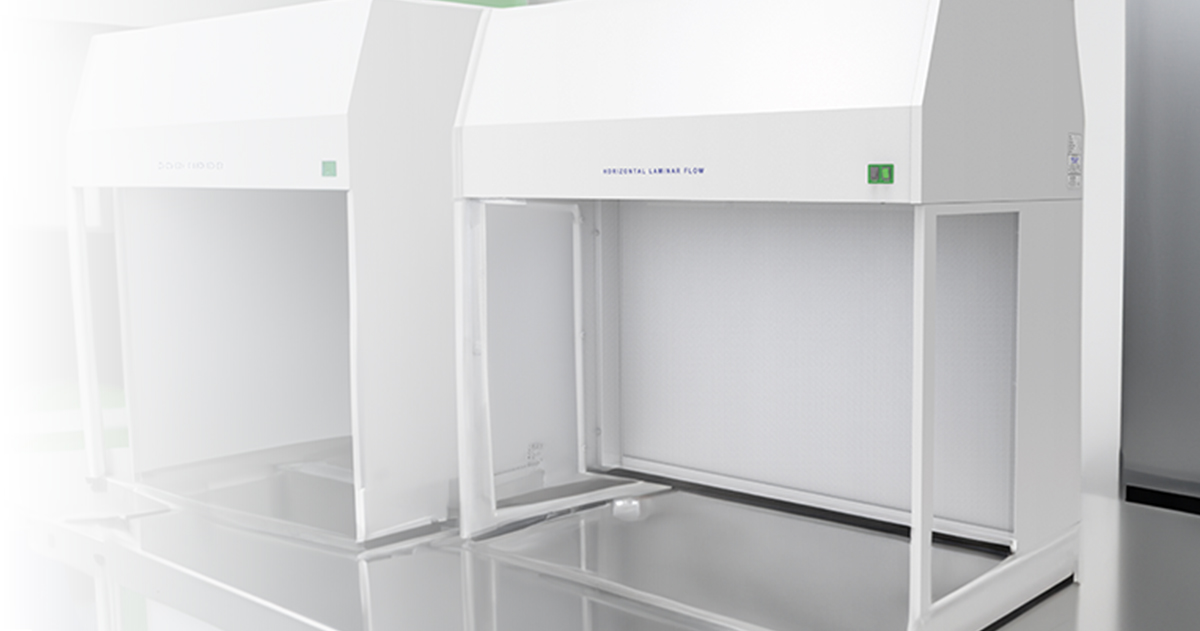Understanding Horizontal and Vertical Laminar Air Flow Cabinets
- By Jeni Thomas
- 11 Jul 2023

As Cleanroomshop introduces a new and improved range of laminar flow cabinets, this blog looks at the pros and cons of vertical laminar flow hoods and horizontal laminar flow hoods to see which one is most appropriate for your application.
Laminar airflow, which refers to the constant and uniform movement of air in a specific direction, plays a crucial role in maintaining a clean and controlled environment. In cleanrooms, vertical laminar flow rooms are where the entire ceiling delivers filtered air downward. This comprehensive filter coverage ensures the creation of an ultra-clean environment. However, achieving laminar flow in larger spaces can be challenging due to the presence of equipment, personnel, and movement, all of which can cause turbulence and disrupt the airflow.
Cleanroomshop offers a solution in the form of laminar flow hoods, widely used as ultra-clean workbenches in laboratory applications. These hoods use filtered air to create a uniform flow that sweeps away particles in a consistent speed and direction, starting from the filter area and exiting through the hood's designated exit area.
Uniform airflow and the use of laminar flow hoods are vital for ensuring that sensitive products placed within the hood remain free from contamination. Laminar flow hoods come in two configurations: horizontal and vertical. Both designs offer an effective sweeping action through the work zone and meet ISO Class 5 cleanliness standards. The choice between the two depends on the specific requirements of your facility and application.
Horizontal Laminar Flow Hoods
Horizontal laminar flow hoods direct the airflow horizontally. The air is pushed through a HEPA or ULPA filter positioned on the back wall and moves forward across the work surface until it exits the enclosure.
Horizontal laminar flow hoods provide the highest protection against contaminating particles by sweeping the air across the work surface towards the operator. This design eliminates the turbulence caused by vertical air striking perpendicular surfaces or the operator's hands, as they are always downstream from the materials they are working on.
However, some considerations are associated with the hood's size, the filter's positioning, and the airflow's direction. Here are the pros and cons of horizontal laminar flow hoods:
Pros:
- Low turbulence on the work surface due to parallel airflow
- Easy positioning of products and materials close to the filter on the work surface
- Minimal contamination from hands or gloves as the operator remains downstream from the products and materials
Cons:
- Requires hood repositioning for rear access during filter changes and servicing
- Objects can obstruct the airflow and contaminate downstream materials
- Improper use of the sash can lead to fume or powder contaminants blowing at the operator
Vertical Laminar Flow Hoods
In contrast, vertical laminar flow hoods draw air from above the unit, push it through the HEPA or ULPA filter, and direct it downwards onto the work surface. The air then disperses and exits the enclosure through a front access area. These hoods resemble the configuration of a laminar flow cleanroom with fan filter units on the ceiling but on a smaller scale.
Vertical laminar flow hoods are popular due to their compact size, layout, and enhanced operator safety. With the filter at the top of the unit, they require less floor space but can be taller to accommodate larger products and materials. Additionally, as the laminar air is not blowing towards the operator, the risk of contaminants reaching sensitive materials is reduced.
Vertical laminar flow hoods suit various applications, including sterile drug compounding in research labs, pharmacies, and microbiology. Here are the pros and cons of vertical laminar flow hoods:
Pros:
- Requires less floor space
- Enhanced operator safety
- Easy access for filter changes and servicing
- Reduced cross-contamination of items on the work surface due to the absence of parallel airflow
- Can accommodate tall and large products and materials due to the taller design
Cons:
- May require overhead clearance for filter changes and servicing
- Increased turbulence on the work surface due to vertical air hitting perpendicular surfaces
- The presence of stacked products and materials can obstruct airflow
Choosing the Right Hood for Your Application
Both horizontal and vertical laminar flow hoods effectively reduce contamination in workspaces involving sensitive products and materials. However, certain applications are better suited to one configuration over the other. Factors such as process location, clearance requirements, material size, work surface design, and operator safety are crucial in determining the ideal choice.
Horizontal laminar flow hoods are generally recommended for applications requiring minimal work surface turbulence and a high level of object contamination control.
Get in Touch with Cleanroomshop
Vertical laminar flow hoods are also an excellent choice for large or potentially hazardous materials applications. Whereas horizontal flow hoods allow the positioning of products and materials close to the filter on the work surface
If your cleanroom requires laminar flow hoods, Cleanroomshop can provide expert advice so you can select the option that seamlessly meets your classification and industry requirements. You can choose from our standard sizes or speak to us about bespoke requirements. Contact us today to speak with our specialist team.
Vertical Laminar Flow Cabinet LFU Horizontal Laminar Flow Cabinet LFU
